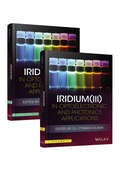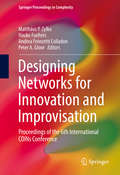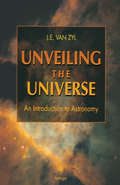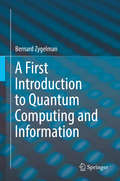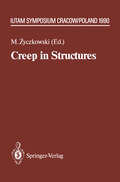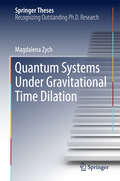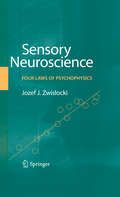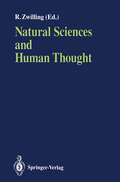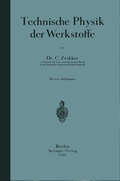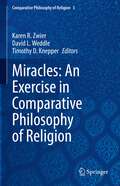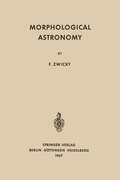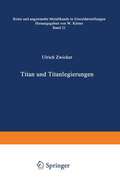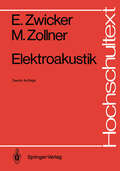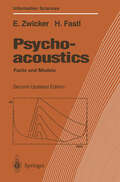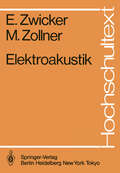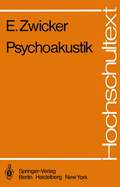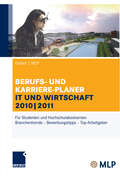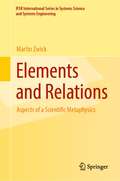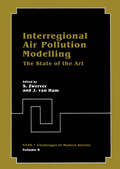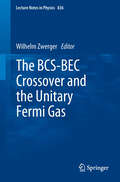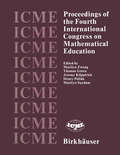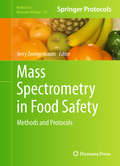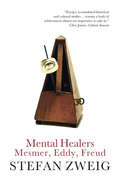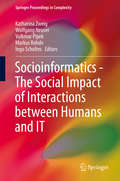- Table View
- List View
Iridium(III) in Optoelectronic and Photonics Applications
by Eli Zysman-ColmanThe fundamental photophysical properties of iridium(III) materials make this class of materials the pre-eminent transition metal complex for use in optoelectronic applications. Iridium(III) in Optoelectronic and Photonics Applications represents the definitive account of photoactive iridium complexes and their use across a wide variety of applications. This two-volume set begins with an overview of the synthesis of these complexes and discusses their photophysical properties. The text highlights not only mononuclear complexes but also the properties of multinuclear and polymeric iridium-based materials and the assembly of iridium complexes into larger supramolecular architectures such as MOFs and soft materials. Chapters devoted to the use of these iridium-based materials in diverse optoelectronic applications follow, including: electroluminescent devices such as organic light emitting diodes (OLEDs) and light-emitting electrochemical cells (LEECs); electrochemiluminescence (ECL); bioimaging; sensing; light harvesting in the context of solar cell applications; in photoredox catalysis and as components for solar fuels. Although primarily targeting a chemistry audience, the wide applicability of these compounds transcends traditional disciplines, making this text also of use to physicists, materials scientists or biologists who have interests in these areas.
Iridium(III) in Optoelectronic and Photonics Applications
by Eli Zysman-ColmanThe fundamental photophysical properties of iridium(III) materials make this class of materials the pre-eminent transition metal complex for use in optoelectronic applications. Iridium(III) in Optoelectronic and Photonics Applications represents the definitive account of photoactive iridium complexes and their use across a wide variety of applications. This two-volume set begins with an overview of the synthesis of these complexes and discusses their photophysical properties. The text highlights not only mononuclear complexes but also the properties of multinuclear and polymeric iridium-based materials and the assembly of iridium complexes into larger supramolecular architectures such as MOFs and soft materials. Chapters devoted to the use of these iridium-based materials in diverse optoelectronic applications follow, including: electroluminescent devices such as organic light emitting diodes (OLEDs) and light-emitting electrochemical cells (LEECs); electrochemiluminescence (ECL); bioimaging; sensing; light harvesting in the context of solar cell applications; in photoredox catalysis and as components for solar fuels. Although primarily targeting a chemistry audience, the wide applicability of these compounds transcends traditional disciplines, making this text also of use to physicists, materials scientists or biologists who have interests in these areas.
Designing Networks for Innovation and Improvisation: Proceedings of the 6th International COINs Conference (Springer Proceedings in Complexity)
by Matthäus P. Zylka Hauke Fuehres Andrea Fronzetti Colladon Peter A. GloorThis volume is focused on the emerging concept of Collaborative Innovation Networks (COINs). COINs are at the core of collaborative knowledge networks, distributed communities taking advantage of the wide connectivity and the support of communication technologies, spanning beyond the organizational perimeter of companies on a global scale. It includes the refereed conference papers from the 6th International Conference on COINs, June 8-11, 2016, in Rome, Italy. It includes papers for both application areas of COINs, (1) optimizing organizational creativity and performance, and (2) discovering and predicting new trends by identifying COINs on the Web through online social media analysis. Papers at COINs16 combine a wide range of interdisciplinary fields such as social network analysis, group dynamics, design and visualization, information systems and the psychology and sociality of collaboration, and intercultural analysis through the lens of online social media. They will cover most recent advances in areas from leadership and collaboration, trend prediction and data mining, to social competence and Internet communication.
Unveiling the Universe: An Introduction to Astronomy
by J.E. van ZylA wealth of material on practically every aspect of astronomy, beginning from the first principles. It is quite unique in providing a level of scientific accuracy and detail to be found in no other introductory book, including coverage of instruments, theory, observation, space exploration and cosmology. Encyclopaedic in its breadth, the book still contains in-depth explanations of the underlying theories. The illustrations - many of them colour photographs - animate the text, itself so clear and concise that it will fascinate readers of every discipline.Winner of the Rapportryers Prize for "most meritorious popular science book".
A First Introduction to Quantum Computing and Information
by Bernard ZygelmanThis book addresses and introduces new developments in the field of Quantum Information and Computing (QIC) for a primary audience of undergraduate students. Developments over the past few decades have spurred the need for QIC courseware at major research institutions. This book broadens the exposure of QIC science to the undergraduate market. The subject matter is introduced in such a way so that it is accessible to students with only a first-year calculus background. Greater accessibility allows a broader range of academic offerings. Courses, based on this book, could be offered in the Physics, Engineering, Math and Computer Science departments. This textbook incorporates Mathematica-based examples into the book. In this way students are allowed a hands-on experience in which difficult abstract concepts are actualized by simulations. The students can ‘turn knobs" in parameter space and explore how the system under study responds. The incorporation of symbolic manipulation software into course-ware allows a more holistic approach to the teaching of difficult concepts. Mathematica software is used here because it is easy to use and allows a fast learning curve for students who have limited experience with scientific programming.
Creep in Structures: 4th IUTAM Symposium, Cracow, Poland September 10–14,1990 (IUTAM Symposia)
by Michal ZyczkowskiThere is a tradition to organize IUTAM Symposia "Creep in Structures" every ten years: the first Symposium was organized by N.J. Hoff in Stan ford (1960), the second one by J. Hult in Goteborg (1970), and the third one by A.R.S. Ponter in Leicester (1980). The fourth Symposium in Cracow, September 1990, gathered 123 par ticipants from 21 countries and reflected rapid development of the theory, experimental research and structural applications of creep and viscoplas ticity, including damage and rupture. Indeed, the scope of the Sympo sium was broad, maybe even too broad, but it was kept according to the tradition. Probably the chairman of "Creep in Structures V" in the year 2000 (if organized at all) will be forced to confine the scope substantially. Participation in the Symposium was reserved for invited participants, suggested by members of the Scientific Committee. Total number of sug gestions was very large and the response - unexpectedly high. Apart from several papers rejected, as being out of scope, over 100 papers were accepted for presentation. A somewhat unconventional way of presenta tion was introduced to provide ample time for fruitful and well prepared discussions: besides general lectures (30 minutes each), all the remain ing papers were presented as short introductory lectures (10 minutes) followed by a I-hour poster discussion with the authors and then by a general discussion. Such an approach made it possible to present general ideas orally, and then to discuss all the papers through and through.
Quantum Systems under Gravitational Time Dilation (Springer Theses)
by Magdalena ZychThis thesis introduces a new theoretical tool to explore the notion of time and temporal order in quantum mechanics: the relativistic quantum "clock" framework. It proposes novel thought experiments showing that proper time can display quantum features, e.g. when a “clock” runs different proper times in superposition. The resulting new physical effects can be tested in near-future laboratory experiments (with atoms, molecules and photons as "clocks"). The notion of time holds the key to the regime where quantum theory and general relativity overlap, which has not been directly tested yet and remains largely unexplored by the theory. The framework also applies to scenarios in which causal relations between events become non-classical and which were previously considered impossible to address without refuting quantum theory. The relativistic quantum "clock" framework offers new insights into the foundations of quantum theory and general relativity.
Sensory Neuroscience: Four Laws Of Psychophysics
by Jozef J. ZwislockiSensory Neuroscience: Four Laws of Psychophysics organizes part of psychophysics -- a science of quantitative relationships between human sensations and the stimuli that evoke them. Although psychophysics belongs to sensory neuroscience, and is coupled to neurophysiology, it has also branched out to various specialized disciplines, including the disciplines of vision and hearing, ophthalmology, optometry, otology, and audiology. Due to this diversification and fragmentation, psychophysics has had an ad-hoc, phenomenological orientation. Besides Weber’s law of differential sensitivity, and the still-controversial Stevens’ power law, it has lacked a systematic grid of scientific laws. Sensory Neuroscience: Four Laws of Psychophysics provides valid unifying principles and systematic applications for this otherwise fragmented precursor of experimental psychology, and defines four multisensory relationships of substantial generality between sensations and the underlying stimulus variables. This book will be particularly useful to auditory researchers, experimental psychologists, and behavioral neuroscientists.
Natural Sciences and Human Thought
by Robert ZwillingLeaving aside for once all utilitarian considerations, this book attempts to demonstrate the role and influence of the natural sciences in the development of human thought and in shaping the way in which we perceive the world. This seems to be particularly necessary in the present day and age, in view of the fact that a large section of the public is scarcely aware of the great cultural contribution that the natural sciences make towards moulding our conception of the world and scarcely acknowledges their function in helping us to find our bearings in a world that is becoming increasingly complex.
Technische Physik der Werkstoffe
by C. ZwikkerDieser Buchtitel ist Teil des Digitalisierungsprojekts Springer Book Archives mit Publikationen, die seit den Anfängen des Verlags von 1842 erschienen sind. Der Verlag stellt mit diesem Archiv Quellen für die historische wie auch die disziplingeschichtliche Forschung zur Verfügung, die jeweils im historischen Kontext betrachtet werden müssen. Dieser Titel erschien in der Zeit vor 1945 und wird daher in seiner zeittypischen politisch-ideologischen Ausrichtung vom Verlag nicht beworben.
Miracles: An Exercise in Comparative Philosophy of Religion (Comparative Philosophy of Religion #3)
by Karen R. Zwier David L. Weddle Timothy D. KnepperThis volume provides a comparative philosophical investigation into a particular concept from a variety of angles—in this case, the concept of “miracle.” The text covers deeply philosophical questions around the miracle, with a multiplicity of answers. Each chapter brings its own focus to this multifaceted effort. The volume rejects the primarily western focus that typically dominates philosophy of religion and is filled with particular examples of miracle narratives, community responses, and polemical scenarios across widely varying religious contexts and historical periods. Some of these examples defy religious categorization, and some papers challenge the applicability of the concept “miracle,” which is of western and monotheistic origin. By examining miracles thru a wide comparative context, this text presents a range of descriptive content and analysis, with attention to the audience, to the subjective experiences being communicated, and to the flavor of the narratives that come to surround miracles. This book appeals to students and researchers working in philosophy of religion and science, as well those in comparative religion. It represents, in written form, some of the perspectives and dialogue achieved in The Comparison Project’s 2017–2019 lecture series on miracles. The Comparison Project is an enterprise in comparing a variety of religious voices, allowing them to stand in dialogue.
Morphological Astronomy
by Fritz ZwickyMan has a great tendency to get lost or to hide, as the case may be, in a jungle of details and in unnecessary complications. Why do anything simply if you can do it complicated? And still, life itself presents a sufficient number of problems to keep us busy. There would seem to be no need to create additional difficulties, just for the fun of it, especially if these self-made difficulties become practically insuperable and if in the end they cause much unhappiness. The morphological mode of thought and of action was conceived to break the vicious hold which the parasitic wild growth of complications exerts on life in all of its phases. Morphological thought and action are likely to be of value in all human activities, once such thought and action have been clearly delineated and fully developed, and once they have been practised by a sufficiently large number of people. Since the morphological method is of the greatest universality, the choice of the field to which one applies it first is not particulary critical. The author intends to write two or three books on the morphology of several large scale problems, which are both of a technical and of a general social nature. The present book is concerned in particular with some implications of morphological thinking in astronomy. We shall above all emphasize the basic character of the morphological approach, and we shall demonstrate its constructive power in a number of specific cases.
Titan und Titanlegierungen (Reine und angewandte Metallkunde in Einzeldarstellungen #21)
by U. ZwickerElektroakustik (Hochschultext)
by Eberhard Zwicker Manfred ZollnerDer große Bereich der Elektroakustik wird mit Schwerpunkten auf den Gebieten der Schallfelder, der Wandler und ihres Betriebsverhaltens, der Raumakustik sowie der Aufnahme- und Speichertechnik erläutert. Neben Einführungen, Gleichungen und graphischen Darstellungen wird insbesondere anhand von anwendungsbezogenen Beispielen dem Leser die direkte Lösung von Problemen angeboten, wobei auch neue Verfahren diskutiert werden. Die Eigenschaften des menschlichen Gehörs werden dabei ebenso berücksichtigt, wie die Meßtechnik und die Lärmbekämpfung. Der in der Industrie tätige und der beratende Ingenieur sowie der Student werden angesprochen; aber auch der elektroakustisch interessierte Amateur findet im vorliegenden Buch Antworten auf Fragen der Beschallungstechnik.
Psychoacoustics: Facts and Models (Springer Series in Information Sciences #22)
by Eberhard Zwicker Hugo FastlPsychoacoustics - Facts and Models represents a comprehensive collection of data describing the processing of sound by the human hearing system. It includes quantitative relations between sound stimuli and auditory perception in terms of hearing sensations. In addition, quantitative psychoacoustic models of hearing sensations are given. The monograph contains a unique collection of data on the human hearing system as a receiver of acoustic information as well as many examples of the practical application of the results of basic research in fields such as audiology, noise evaluation, and sound engineering. Many helpful hints for the solution of practical problems will be of particular benefit to engineers, and the book as a whole should serve as an important benchmark in the field of psychoacoustics. The treatment given in this second edition has been thoroughly updated with recent results.
Gabler | MLP Berufs- und Karriere-Planer IT und Wirtschaft 2010 | 2011: Für Studenten und Hochschulabsolventen
by Volker Zwick Marion Zwick Elke Pohl Thomas JendroschDer neu konzipierte und stärker auf IT-Trends fokussierte Berufs- und Karriere-Planer IT und Wirtschaft 2010 | 2011 ist der passgenaue Ratgeber für alle Examenskandidaten und Hochschulabsolventen der Informatik und verwandter Studienfächer, die nach dem Studium in den Beruf durchstarten wollen. Aktuelle Arbeitsmarktanalysen mit wichtigen Brancheninfos, insbesondere die Darstellung zukunftsweisender und wirtschaftlich relevanter IT-Wachstumfelder, vermitteln Einblick in interessante Bereiche für den Jobeinstieg und informieren über die gefragten Qualifikationen. Schwerpunkt des Buchs ist ein sehr nützlicher Bewerberleitfaden. Die praktische Anleitung befasst sich mit allen Aspekten des Bewerbungsprozesses und lässt keine Fragen offen. "Ein Handbuch, das in keinem Bücherschrank fehlen sollte …" Hochschul-Anzeiger
Elements and Relations: Aspects of a Scientific Metaphysics (IFSR International Series in Systems Science and Systems Engineering #35)
by Martin ZwickThis book develops the core proposition that systems theory is an attempt to construct an “exact and scientific metaphysics,” a system of general ideas central to science that can be expressed mathematically. Collectively, these ideas would constitute a nonreductionist “theory of everything” unlike what is being sought in physics. Inherently transdisciplinary, systems theory offers ideas and methods that are relevant to all of the sciences and also to professional fields such as systems engineering, public policy, business, and social work. To demonstrate the generality and importance of the systems project, the book structures its content in three parts: Essay, Notes, and Commentary. The Essay section is a short distillation of systems ideas that illuminate the problems that many types of systems face. Commentary explains systems thinking, its value, and its relation to mainstream scientific knowledge. It shows how systems ideas revise our understanding of science and how they impact our views on religion, politics, and history. Finally, Notes contains all the mathematics in the book, as well as scientific, philosophical, and poetic content that is accessible to readers without a strong mathematical background. Elements and Relations is intended for researchers and students in the systems (complexity) field as well as related fields of social science modeling, systems biology and ecology, and cognitive science. It can be used as a textbook in systems courses at the undergraduate or graduate level and for STEM education. As much of the book does not require a background in mathematics, it is also suitable for general readers in the natural and social sciences as well as in the humanities, especially philosophy.
Interregional Air Pollution Modelling: The State of the Art (Nato Challenges of Modern Society #9)
by S. Zwerver J. van DamThe North Atlantic Treaty Organization (NATO) established the "Committee on the Challenges of Modern Society" (CCMS) at the November 1969 meeting of the North Atlantic Council. The CCMS was charged with developing meaningful environmen tal and social programs that complement other international pro grams, and with showing leadership, first, in solution of exist ing problems and, second, in development of long-range goals for environmental protection in the NATO sphere of influence and in other countries as well. A first Pilot Study on Air Pollution was initiated by the CCMS at its inaugural meeting in December 1969. It resulted in documents about the definition of criteria for the effects of air pollutants as well as the development of assess ment methods for air quality in urban areas. A second Air Pollution Pilot Study (1975-1979) worked out the basics for setting up assessment methods for emissions inven tories, techniques for the practical application of meteorologi cal diffusion models as well as the development of guidelines for an Air Quality Management System (AQMS). Within this second Air Pollution Pilot Study attention to modelling concentrated on the Gaussian Plume Model. A third Pilot Study on Air Pollution Control Strategies and Impact Modelling then was initiated in 1979 and started in 1980.
The BCS-BEC Crossover and the Unitary Fermi Gas (Lecture Notes in Physics #836)
by Wilhelm ZwergerRecent experimental and theoretical progress has elucidated the tunable crossover, in ultracold Fermi gases, from BCS-type superconductors to BEC-type superfluids. The BCS-BEC Crossover and the Unitary Fermi Gas is a collaborative effort by leading international experts to provide an up-to-date introduction and a comprehensive overview of current research in this fast-moving field. It is now understood that the unitary regime that lies right in the middle of the crossover has remarkable universal properties, arising from scale invariance, and has connections with fields as diverse as nuclear physics and string theory. This volume will serve as a first point of reference for active researchers in the field, and will benefit the many non-specialists and graduate students who require a self-contained, approachable exposition of the subject matter.
Proceedings of the Fourth International Congress on Mathematical Education
by M. Zweng Green Kilpatrick Pollack SuydamHenry O. Pollak Chairman of the International Program Committee Bell Laboratories Murray Hill, New Jersey, USA The Fourth International Congress on Mathematics Education was held in Berkeley, California, USA, August 10-16, 1980. Previous Congresses were held in Lyons in 1969, Exeter in 1972, and Karlsruhe in 1976. Attendance at Berkeley was about 1800 full and 500 associate members from about 90 countries; at least half of these come from outside of North America. About 450 persons participated in the program either as speakers or as presiders; approximately 40 percent of these came from the U.S. or Canada. There were four plenary addresses; they were delivered by Hans Freudenthal on major problems of mathematics education, Hermina Sinclair on the relationship between the learning of language and of mathematics, Seymour Papert on the computer as carrier of mathematical culture, and Hua Loo-Keng on popularising and applying mathematical methods. Gearge Polya was the honorary president of the Congress; illness prevented his planned attendence but he sent a brief presentation entitled, "Mathematics Improves the Mind". There was a full program of speakers, panelists, debates, miniconferences, and meetings of working and study groups. In addition, 18 major projects from around the world were invited to make presentations, and various groups representing special areas of concern had the opportunity to meet and to plan their future activities.
Mass Spectrometry in Food Safety: Methods and Protocols (Methods in Molecular Biology #747)
by Jerry ZweigenbaumAs a key component of human survival, a safe and sufficient food supply is essential for a healthy and productive population throughout the world, so assurance that the food supply is clean and free of harmful substances is a global concern. In Mass Spectrometry in Food Safety: Methods and Protocols, experts in the field provide context to the subject through reviews of regulations in various countries, the current state-of-the art, and specific, detailed scientific methods being employed today. The volume thoroughly covers the key areas in food safety, such as detection of low level chemical residues, pesticide analysis aided by chromatographic techniques, and the revealing of mycotoxins and chemical contaminants from packaging materials. Written in the highly successful Methods in Molecular Biology™ series format, method chapters contain introductions to their respective topics, lists of the necessary materials and reagents, step-by-step, readily reproducible laboratory protocols, and tips on troubleshooting and avoiding known pitfalls. Pertinent and cutting-edge, Mass Spectrometry in Food Safety: Methods and Protocols serves researchers with both understanding and appreciation for the contribution of mass spectrometry and its vital application to food testing and food safety.
Mental Healers: Mesmer, Eddy and Freud
by Stefan ZweigFranz Mesmer, Mary Baker Eddy and Sigmund Freud—three influential thinkers who travelled very different paths in their search for the crucial link between mind and body. Zweig's brilliant study explores the lives and work of these important figures, raising provocative questions regarding the efficacy and even the morality of their methods. An insight into the minds of three key thinkers who shaped the philosophy of our age, Mental Healers is a wonderfully intriguing and thought-provoking biographical work from a renowned master of the genre.
Socioinformatics - The Social Impact of Interactions between Humans and IT: The Social Impact Of Interactions Between Humans And It (Springer Proceedings in Complexity)
by Katharina Zweig Wolfgang Neuser Volkmar Pipek Markus Rohde Ingo ScholtesSocioinformatics is a new scientific approach to study the interactions between humans and IT. These proceedings are a collection of the contributions during a workshop of the Gesellschaft für Informatik (GI). Researchers in this emerging field discuss the main aspects of interactions between IT and humans with respect to; social connections, social changes, acceptance of IT and the social conditions affecting this acceptance, effects of IT on humans and in response changes of IT, structures of the society and the influence of IT on these structures, changes of metaphysics influenced by IT and the social context of a knowledge society.
